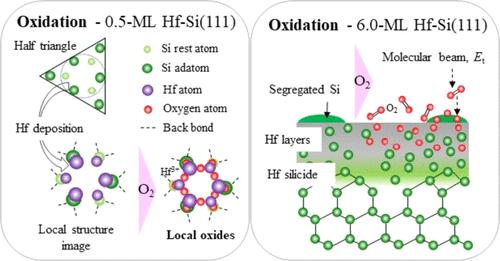Coverage Dependence upon Early Oxidation Stages of Hafnium-Adsorbed Si(111)-7 × 7
IF 3.2
3区 化学
Q2 CHEMISTRY, PHYSICAL
引用次数: 0
Abstract
Coverage dependence on the early oxidation stages of hafnium–adsorbed silicon (111) [Hf–Si(111)] was investigated by synchrotron radiation X-ray photoelectron spectroscopy. The Hf–Si(111) surface with a 0.5 monolayer (ML) comprised Hf tetrasilicide (HfSi4) and Hf monosilicide (HfSi). HfSi4 is inferred to be single Hf adsorption around the Si rest-atoms/corner-holes on the 7 × 7 reconstructed surface, while HfSi is inferred to be a unit of six Hf atoms adsorbed on the top of the Si center adatoms/rest-atoms on the same surface. HfSi was oxidized by exposure to thermal oxygen molecules (O2) with a translational energy (Et) of 0.03 eV; subsequently, a surface passivation behavior was observed. HfSi4 was oxidized by supersonic O2 beam (SOMB) irradiation at Et = 0.39 eV. In Hf–Si(111) with six MLs, Si migration into the Hf overlayers and segregation on the surface were observed by depth profiling. The segregated Si atoms were oxidized by SOMB irradiation with Et = 2.2 eV. The interfacial compounds of metallic Hf, HfSi, and HfSi4 remained regardless of the Et of the impinging O2 because no oxygen reached near the Si substrate. The oxide composition and distribution near the surface were completely different depending on the Hf coverage.

铪吸附 Si(111)-7 × 7 早期氧化阶段的覆盖率依赖性
通过同步辐射 X 射线光电子能谱研究了铪吸附硅 (111) [Hf-Si(111)] 早期氧化阶段的覆盖率。具有 0.5 单层(ML)的 Hf-Si(111)表面由四硅化铪(HfSi4)和单硅化铪(HfSi)组成。根据推断,HfSi4 是在 7 × 7 重构表面的硅中心原子/角孔周围吸附的单个 Hf 原子,而 HfSi 则是在同一表面的硅中心原子/中心原子顶部吸附的六个 Hf 原子单元。将 HfSi 暴露于热氧分子 (O2) 中,其平移能 (Et) 为 0.03 eV,从而使其氧化;随后观察到表面钝化行为。在 Et = 0.39 eV 的超音速氧气束 (SOMB) 照射下,HfSi4 被氧化。在具有六个 ML 的 Hf-Si(111)中,通过深度剖析观察到硅向 Hf 覆盖层迁移以及在表面发生偏析。偏析的硅原子在 Et = 2.2 eV 的 SOMB 辐照下被氧化。由于没有氧气到达硅基底附近,因此无论冲入的 O2 的 Et 如何,金属 Hf、HfSi 和 HfSi4 的界面化合物都保持不变。表面附近的氧化物成分和分布完全不同,这取决于 Hf 的覆盖率。
本文章由计算机程序翻译,如有差异,请以英文原文为准。
求助全文
约1分钟内获得全文
求助全文
来源期刊

The Journal of Physical Chemistry C
化学-材料科学:综合
CiteScore
6.50
自引率
8.10%
发文量
2047
审稿时长
1.8 months
期刊介绍:
The Journal of Physical Chemistry A/B/C is devoted to reporting new and original experimental and theoretical basic research of interest to physical chemists, biophysical chemists, and chemical physicists.
 求助内容:
求助内容: 应助结果提醒方式:
应助结果提醒方式:


